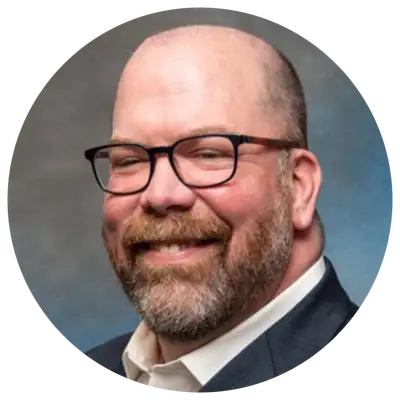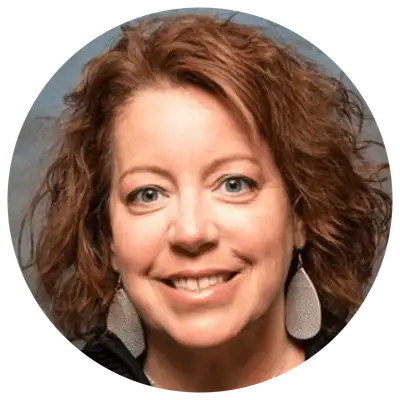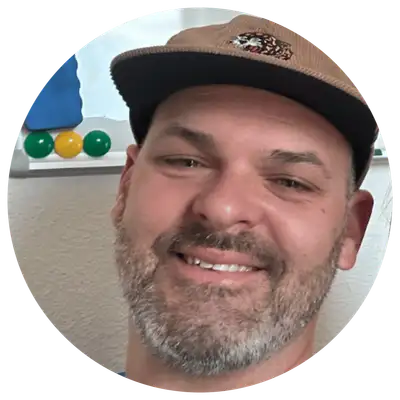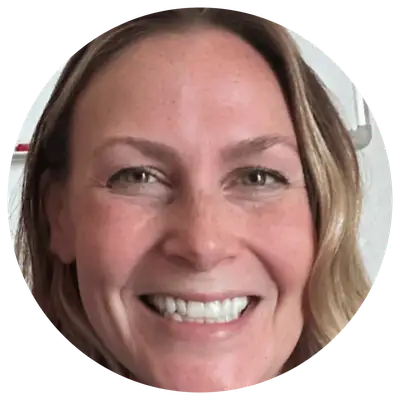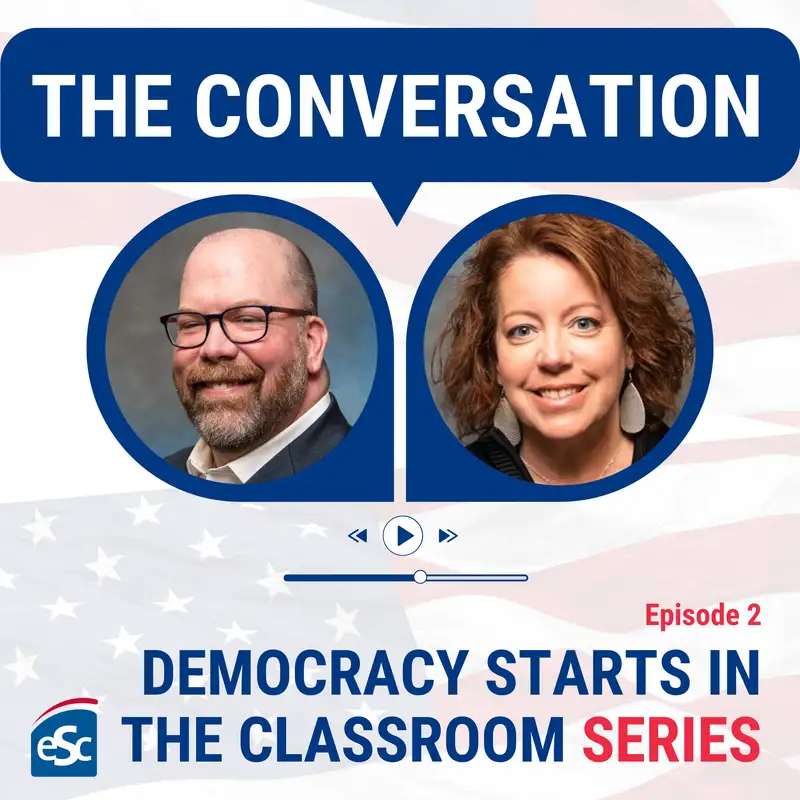
Voices in Conflict
Susan Nolan:
A couple of students this past semester shared that it helped open up doors within their families for certain conversations that they wanted to broach that maybe they didn't agree with parents, or siblings, or something like that on a topic and had heard specific thoughts about that, and then felt differently and were able to engage in those conversations in a mature fashion, instead of it being reactionary.
Speaker 1:
That was Susan Nolan, a teacher at Village Springs in Colorado Springs, Colorado. On this episode of The Conversation, John and Rachel sit down with Susan and her co-teacher, Dan Tackas. Together, they dive into their thought-provoking course, Voices in Conflict, which challenges students to explore diverse perspectives and embrace new ideas. This episode is part of our ongoing series, Democracy Starts in the Classroom, designed to keep you engaged and informed this election season. Let's dive in.
John Hambrick:
Hello and welcome back to The Conversation, Ohio voices in education, igniting ideas, inspiring change. And in this theme of civics education, we're going out of Ohio for this conversation as my esteemed colleague Rachel Daniels and I are going to be talking with Susan Nolan and Dan Tackas, going forward known as Tack, from the Village High School, Colorado Springs, Colorado. So, I welcome everyone here to the conversation today and to help get this rolling for our listeners, Susan, Tack, can you tell us a little bit about yourselves, your unique school, and the course that you teach, Voices in Conflict?
Dan Tackas:
Yeah, sure. Thanks for having us by the way. Yeah, you want to go for it?
Susan Nolan:
You want me to start? Sure. So, I've been a high school teacher for about 14 years. I was in a traditional school for the first seven, and I've been here at Village High School for seven.
Dan Tackas:
Yeah. Well, I'm Tack. I've been here for three years, teaching for 16 in total. So, the course we teach, Voices in Conflict, is one of my favorite courses I've ever had the pleasure of teaching, where I guess, teaching isn't a good word, it's-
Susan Nolan:
It's facilitating.
Dan Tackas:
... Facilitating. Yeah, yeah. More facilitating and guiding students into how to have a conversation. That's the class. And, more importantly, how to have a conversation about the stickiest issues that you can think of.
Susan Nolan:
Yeah. And this class fits really well under the umbrella of our school, Village High School. It's a unique school, in that, we have a hybrid model. The core classes, the kids move through those online through an online program that we've hired to take care of those for us, and we are here to help guide them through that when they have issues, we personalize curriculum for them through that program. And then, the electives are what we do in person primarily. And we all teach a variety of electives, because the school is basically about finding your passion, harnessing your passion, and then making that contagious for students, and so they can find and harness theirs, which I think is fantastic. So, while I am designated as an English and PE teacher, Voices in Conflict is sort of its own unique niche within that. And then there's a variety of other classes like global issues and art perspectives that I teach with an art teacher, and just a number of different electives where we get to explore passions with kids.
Dan Tackas:
Absolutely.
John Hambrick:
So, you're having conversations, you're having incredibly rich dialogue. How would this be different than a traditional debate class where you're doing pros and cons?
Dan Tackas:
Yeah. So, in a debate class, you're preparing what you're going to say based off of what the previous person is saying. And it's almost like winning or losing. And this isn't winning or losing at all. And so, part of a conversation is learning really how to listen. And that's one of the first things that we try to do is try to get them to listen, so they're not just thinking about the next thing that they're going to say, because now, we don't have a conversation, we just have two competing viewpoints, it doesn't really get anywhere.
Susan Nolan:
The whole point of this class too is the fact that students that are in high school right now have grown up in a society where what they see are terrible examples of communication on a daily basis.
Dan Tackas:
Right.
Susan Nolan:
They see people arguing, they see it as a win-lose, instead of a discussion where learning can take place and growing can take place through it, and people are pitted against each other and there's a lot of binary ways of thinking. And, we try to break through that and say, "Let's have an actual conversation." And so, we hit those sticky topics, like Tack was saying. The kids choose the topics too, which is great, and then we move them through things in a certain order, which we'll tackle in a moment. But, it makes it so that the kids can own their thoughts. Some of the general rules in the class when we start, which we don't have a lot of rules at all, but one is, one voice at a time, and to make sure it's your own voice, that you're not speaking for other people in your world, but that you are exploring, discovering, and articulating your own thoughts on a matter. We find that to be imperative to having a good conversation and a conversation that can then move forward to learning.
Dan Tackas:
Right.
Rachel Daniels:
Susan and Tack, you are speaking my language. As an adolescent literacy consultant, one of my access points for all educators starts at discourse, and you are presenting the basic building blocks that could change education really at its base. And so, it's really exciting for me to hear you talk about this. I'd love to hear more about the curriculum for the class, who writes it, what topics are discussed. Susan, you talked about how students might have some voice in that. And then, how do students interact with the content? So, if you could take a few moments to just unpack that for us.
Susan Nolan:
Students have all the voice in the curriculum essentially. We don't go in with anything written. The one thing that we do start class with each year that we teach this is it's a conflict style survey for the kids so they can reflect on how they are. Are they more quiet? Do they want to just play mediator? Are they more of that attack personality that's a bit more aggressive and gets on a soapbox? Right? What is their style? We reflect on that to start the class. And then, we have kids think, reflect, research, and look up different topics that they might want to discuss that are obviously topics of conflict in varying degrees, local to global. And we move through that with them.
Dan Tackas:
Right. Yeah. And, I mean, that's the curriculum. It's the kids picking a bunch of topics, but then, that's where the fluidity starts. And that's what's so exciting about this class. Every group of kids is different, and they need different things, and they're at different places, and the topic itself is really secondary to the skills within that topic. And that's where the word teach is funny. We guide and we facilitate what's happening, and then that's where our profession comes in, where we can then bring in the skills and resources that we need to meet kids exactly where they're at in whatever topic we're talking about, whether it's logical fallacies, or how to listen, or how to research. And that's a huge part of it too. We try to get them to come from a place of knowledge, and how to pause, and all that fun stuff.
And so, even in talking about whatever topic we're talking about, we'll pause, and we'll say, "All right, let's take a break for a second. Let's learn this skill. Let's try to incorporate this skill." Whatever it may be into this. "This is what we're hearing. What are you guys feeling?" And then, the fluidity is great. So there is no standard curriculum. There is no day-to-day plan on what's happening, which I think makes the class so, so good.
Susan Nolan:
Yeah. Especially because any day at any time, a new conflict can arise in the world around us, right?
Dan Tackas:
Yes.
Susan Nolan:
And so, we don't want to have the idea for what the next thing is if something else comes up. So we start every class with, "Okay, what do you want to talk about today?" Right? And then, we move through it that way. We start the semester with more, for lack of a better term, softball topics, I guess. And then, as we grow the skills that Tack is mentioning, we are able to blend the soft and hard skills together to move through these conversations in a way that's far more organic, because the kids are prepared now and understand enough practice to the skills to get there.
Dan Tackas:
Yep.
Rachel Daniels:
What's resonating with me is that this course is not just an incubator for thinking and being an active member of society, but also for critical soft skills that every person needs to survive in the world. And so, this is really exciting content to hear about.
Susan Nolan:
Yeah. And I think that what's really important too is because we personalize everything in our school for kids in this elective that looks like individual goal setting for students, where we meet with them numerous times throughout the semester of the course and they can assess, and reassess, and reflect on their progress with certain skillsets that they want to develop.
Dan Tackas:
And then, you said soft skills. That's the model of our school, the information, the content, those subjects, they're out there all... And especially with the advent of the AI, the information is there. So what we focus on is those soft skills in nearly every single class that we do. It's not about the content.
Rachel Daniels:
So, quick quiz, give us three topics or themes that came up last semester.
Dan Tackas:
So, rights of prisoners was one. What does that look like? I don't know what-
Susan Nolan:
Universal health care.
Dan Tackas:
... Universal health care. Yeah.
Rachel Daniels:
Right.
Susan Nolan:
Abortion always comes up.
Dan Tackas:
Abortion always comes up.
Susan Nolan:
Kids are very eager to discuss that.
Dan Tackas:
Right.
Susan Nolan:
But the thing that's beautiful about it is as we progress through the class, kids realize how intertwined so many issues really are and the complexities that go into each and every one, so it's not just a yes/no conversation. It's a beautiful layering. And they start to realize how complicated every conversation really almost should be when you're really discussing it.
Dan Tackas:
Right. Role of social media, those things. One of the first things we talked about is restrictions on screen time to get them excited and stuff like that. But, yeah.
John Hambrick:
I'm curious, how many years have you been teaching this course or guiding kiddos through this course?
Susan Nolan:
So, this class started with another colleague of mine before Tack got here. And so, I think, I've been at the Village about seven years, so it would be about six or seven years that the course has been running at the school. And again, our school is rather new. I think we've been open maybe 10 years now for total. So, everything's brand new. So this class started just a few years into the school being open. As our class size grows, our school population grows in size. And then, Tack and I have been teaching it since he got here three years ago.
John Hambrick:
Fantastic. And so, in that time that you've both been teaching this together, what significant impacts have you observed with your learners? And first, I'll just say, I love that you allow the student to identify their style, right? Are they an observer? Are they a facilitator? Are they a leader in conversations? And then, it'd be really cool to see what the post survey would be at the end, right, where have they developed certain skills? But yeah, I think it's just really cool to find out. How have your students been impacted in any one, two, or three particular examples you'd like to share?
Dan Tackas:
So this is awesome. So, we do that at the end, by the way, we talk to them, the grade essentially, or the marks, or whatever you want to call it in this class, none of this stuff is based on points. It's based on a conversation at the end. Like, "How did you grow? What did you accomplish? What did you do? How did you see yourself become different?" So, one kid, for example, in a totally different class, teacher would come up to us and say, "I saw this kid do something he's never done before in terms of conversation and listening. Thank you." The impact is there, because it's going into other areas of their life, which is amazing.
Susan Nolan:
And a couple of students this past semester shared that it helped open up doors within their families for certain conversations that they wanted to broach that maybe they didn't agree with parents, or siblings, or something like that on a topic and had heard specific thoughts about that, and then felt differently, and were able to engage in those conversations in a mature fashion, instead of it being reactionary, which is really cool to hear about.
Dan Tackas:
Yeah. And it's cool to see, I mean, day one, compared to the last day of the class, it's so different. They're ready to say what they want to say, and then by the end they're listening and talking to each other. And a lot of times, we're just sitting back and we're not saying anything. And that's the whole goal is for them to then run, and we could really get up and walk out and they can keep it going.
Susan Nolan:
Yeah, in each class, we take more of a backseat and more of a backseat, and we're more participants than we are facilitators, which is really cool to see as well. And to Tack's point, so many times, we see students from one class in other classes, because our school, the electives are mostly open 9 through 12th grade, so we can have freshmen with seniors in this class or any other class. And, part of the beauty is that we also get to witness the growth with the students and see them in the different environments and how they're then applying to Tack's point of other adults noticing and coming up to us. But we get to witness those light bulbs continue to go off them in other areas as well.
John Hambrick:
I love hearing the maturity of the skill, and then how transferable that skill is not just in the classroom amongst peers, but they take that into family and maybe they had a sibling that they just weren't comfortable having a good conversation with. And here, they are. I don't want to keep capitalizing. I want to give my friend, Rachel, some time. But one more question for you. Could you do a typical day in your classroom? Can you share what that could look like for our listeners?
Dan Tackas:
Sure.
Susan Nolan:
Yeah. I think, we come in, we gather, "How's your day? How are you feeling today? How was the weekend?" Whatever's going on, just in general conversation. And then, we essentially dive right into, "What are we talking about today? Here are some topics that you guys had mentioned, what's going on in the world that you've seen, that you've heard about that you want to now discuss." And then, sometimes, there's more than one topic brought forward. So, we literally will just be like, "Who wants to talk about this today versus this another day?" And they'll essentially vote, right? And then, we just run with it from there.
Dan Tackas:
Or somebody just starts talking, because something happened and we start talking. And sometimes, there's really awkward silences.
Susan Nolan:
I love those.
Dan Tackas:
Those are great, because just nobody's saying anything, and we just sit there and look at each other. And, we wait, yeah, until people start moving through. And so, that's what it is, and that's the entire class.
Susan Nolan:
Mm-hmm.
Dan Tackas:
And then, by the end, we will pause with five or six minutes left and reflect on what we just did. And then, we say, "All right, do we want to continue this? We were in a great conversation." Or, everybody knows that thing sputtered out 15 minutes ago, and we'll start something else.
Susan Nolan:
We try and just keep them on topic as much as possible, again, because so many issues are so layered and complex, it's natural to have at least some movement in the conversation. That's not a complete digression, but that's some movement in that conversation. So if there is a total digression, we do try and just bring them back to it. But it happens in real life conversation too. Right? We just want to make sure that we give the conversation itself and how to have the conversation the value that it deserves each time.
Dan Tackas:
And then, when we need to pause, when we see that we need to focus on a certain skill, we will. We'll say, "Let's pause. We're going to focus on this skill. This is what we're hearing." And then, we'll go to our whatever bag of resources we have and start teaching that skill.
Susan Nolan:
"Yeah, I'm hearing mostly anecdotal evidence. Let's talk about that." Or, one student will remark on another student's comment and be like, "That was a false equivalency." And we'll get back into those skills as well and some different information for them to move from.
Dan Tackas:
Yeah.
Rachel Daniels:
What I appreciate hearing from you is that you both are really utilizing the art of teaching and understanding talk moves, understanding how to coach students, also understanding and appreciating quiet, and wait time, and think time. And I think that in traditional classroom settings, we're not always in that head space. Content coverage can be king, and you all are at the other end of the continuum with that. So I imagine in our listening audience, we have some educators who are thinking, "Ooh, this is exactly the way I'd like to see my classroom moving." So, could you talk to us about how an educator who is interested in a similar approach might be able to create their own version of Voices in Conflict?
Dan Tackas:
Yeah, this is going to be fun. At first, you have to let go of everything that they told you to do. I mean, honestly-
Susan Nolan:
And let go of the fear. I think there's a lot of fear in traditional settings, whether it's conscious or subconscious as you move through your day with your students, how you interact with them, and this is a very human class and a very human school. And, it's very person-centric here. And, because of that, to Tack's point, to let go of those things and to just have a conversation, right, and to just not be afraid of that.
Dan Tackas:
... Yeah.
Susan Nolan:
Of course, in most traditional environments, you are at the mercy of being over-managed.
Dan Tackas:
Yeah, the power is to be.
Susan Nolan:
Is that a kind way of saying that?
Dan Tackas:
Yeah. "You got to get through this page of the book." Or whatever. As a history teacher, "If you don't get to World War II, we've got problems because the state test..." Whatever. It's not about the content in this class. And you got to let go of that. You got to let go of what we might not talk about and focus on what we are talking about.
Susan Nolan:
And, even use the content as a springboard, right? If you're in science class, you could bring up a bioethics matter. If you're in English class, there's so much to discuss. History class, right? I think that if the fear is having a singular class that is this, that is an elective, then there are definitely ways to integrate it into the everyday classroom if you're comfortable with that. But in order to really have this class, it's going to take the dedication, the time, the patience with yourself too. I learn every single semester that we teach this, in so many different ways about myself, about others, about the topics that are out there, the conflicts themselves, the underlying complexities of everything. And I think that if you're open to being a fellow learner more than a teacher in your mindset, then this class can really grow and be a beautiful thing.
Dan Tackas:
Exactly.
Rachel Daniels:
Well, you have summed it up in a way that I often conceptualize teaching, and I say, "We shouldn't be called teachers. We should be called lead learners." Right? We should be really encouraging learning, but continue our own learning. So, with that, Susan and Tack, I want to thank you for joining us today. We continue to be intrigued by this course, Voices in Conflict, and we really value the way that both of you nurture students as learners and as members of our greater society. So, for John, this is Rachel, take care, stay curious, and keep the conversation going.
Creators and Guests
